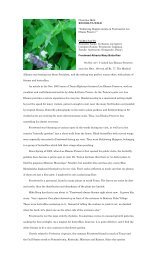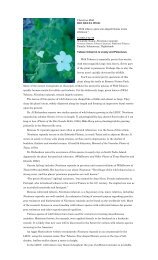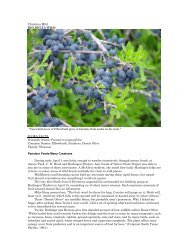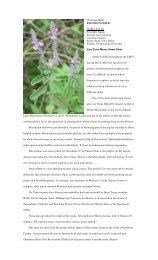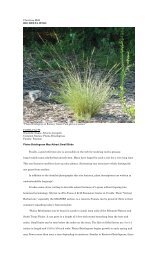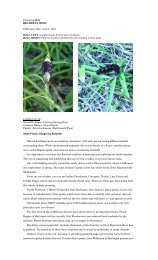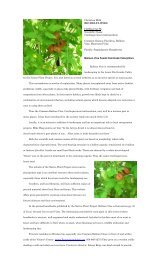Abutilon hulseanum.pdf - Christina Mild's "Rio Delta Wild"
Abutilon hulseanum.pdf - Christina Mild's "Rio Delta Wild"
Abutilon hulseanum.pdf - Christina Mild's "Rio Delta Wild"
Create successful ePaper yourself
Turn your PDF publications into a flip-book with our unique Google optimized e-Paper software.
<strong>Christina</strong> MildRIO DELTA WILDPublication Date: July 10, 2004Jann Miller re-discovered <strong>Abutilon</strong> <strong>hulseanum</strong>, not seen in Texas for many years.Blooms of this mallow open in late afternoon.FLORA FACTSScientific Name: <strong>Abutilon</strong> <strong>hulseanum</strong>Common Names: Jann’s Pink <strong>Abutilon</strong>, MauveFamily: Malvaceae (Mallow)Pretty Pink Mallow RediscoveredJann Miller recently discovered large colonies of a pretty pink mallow. “Pink…” Jann thought,as she drove past the plant. “A pink mallow….” She knew of red mallows, a dark pink one, lowgrowingorange mallows and several types of tall, yellow-blooming mallows. But a light pink onewas a real surprise.Ken King was enlisted for help in identification. He ascertained that this meter-high mallow,with beautiful heart-shaped leaves, was a type of <strong>Abutilon</strong>. Dr. Al Richardson was the nextenlistee. He identified the pretty plant as <strong>Abutilon</strong> <strong>hulseanum</strong>, collected years ago in the LRGV,but not observed in the area for quite some time.On June 14 th , I accompanied a group of plant lovers to photograph Jann’s exciting find. Weventured out late in the afternoon, as the blooms of <strong>Abutilon</strong> <strong>hulseanum</strong> open around 4 p.m.You might think that a plant which waits until late afternoon isn’t all that exciting until yourealize that many other plants close their blooms when afternoon approaches.The blooms of this mallow appear pink from a distance. On closer inspection, one notesdelicate reddish adornment on the bloom’s periphery and an overall wash of yellow. Differentfolks describe the flowers as mauve, peach or rose.The foliage of this plant is very nice as well. The typical leaf covering of a mallow is hairy, withthe minute hairs arranged as intricate star-like patterns. Leaves of <strong>Abutilon</strong> <strong>hulseanum</strong> catchlight with these refractive surfaces and scatter it into a lovely, soft glow.Admiring the plant was the first order of business. Then we began to ponder why Jann Millerhad ever ventured to the remote place where this colony grows.“I was on a quest for the place where Zachary Taylor crossed the Arroyo Colorado with histroops,” Jann told me when I called her up. “I just love the Thursday local history section in theValley Morning Star. I was looking for the place where the old Paso Real crosses the Arroyo. A lotof the old pathway was scraped away in the twenties. It was an old Indian trail; then oxcarts usedit. An old stagecoach line carried cotton on that trail during the Civil War. I finally found it. I wasthinking about how brave Zachary Taylor was. There were Mexicans on the other side of theArroyo, ready to attack his troops.”Jann was pretty much alone on her search for traces of history.A lot of people became involved once she found <strong>Abutilon</strong> <strong>hulseanum</strong>. “I’ve been looking for thatplant for years,” Mike Heep told me.
Directions to Location of plant:Pass Camp Perry, note Santa Monica signNote first floodway leveeAt 2 nd levee, pass overThen take immediate next right onto a dirt rd.: Rt. 1421.Alternate route:From SebastianGo East on 1018 until it ends.Continue straight on dirt/caliche Road along the levee1 st stand of pink abutilon is on the right about ¼ mile.Continue to the end of the road until it turns left.Go left about ¼ to ½ mile and plants are across ditch on right.(directions from Frank Wiseman: 364-1410)



